#voice api integration
Explore tagged Tumblr posts
Text
EnableX Voice API Pricing: Understanding Costs and Features for Developers
EnableX Voice API Pricing: Understanding Costs and Features for Developers
In the ever-evolving landscape of communication technology, Voice APIs play a crucial role in enabling developers to integrate voice functionalities into applications. Stands out as a comprehensive platform providing robust Voice API solutions. Understanding the pricing and features of EnableX Voice API is vital for developers aiming to optimize their applications' communication capabilities. This article delves into the various cost structures, key features, and benefits that offer, providing a comprehensive guide for developers.

Overview of EnableX Voice API
EnableX provides a powerful Voice API that allows developers to build, manage, and scale voice communications within their applications. This API supports a wide range of functionalities, including voice calls, conference calls, interactive voice response (IVR), and more. The flexibility and scalability of make it a preferred choice for many developers and businesses.
Key Features of EnableX Voice API
High-Quality Voice Calls ensure crystal-clear voice quality, essential for both personal and professional communications.
Global Reach With support for international calling allows developers to connect users across the globe seamlessly.
Scalability The API can handle a high volume of calls, making it suitable for both small-scale and large-scale applications.
Customizable IVR Interactive Voice Response (IVR) systems can be customized to meet specific business needs, enhancing user experience.
Call Recording provides call recording capabilities, which are crucial for compliance, training, and quality assurance.
Real-Time Analytics Developers can access real-time analytics and insights, helping them monitor and optimize their voice communications.
Secure Communications prioritizes security, offering encrypted communications to ensure data privacy and integrity.
Pricing Structure Understanding the pricing structure of Voice API is critical for budget planning and cost management. offers a flexible pricing model that caters to different usage patterns and business needs.
Pay-As-You-Go EnableX adopts a pay-as-you-go pricing model, where users are charged based on their actual usage. This model is beneficial for startups and small businesses with variable usage patterns, as it allows them to scale their spending in line with their needs.
Per-Minute Charges: Users are billed based on the duration of the voice calls. This charge varies depending on the destination of the call (domestic or international).
No Upfront Costs: There are no initial setup fees, making it easier for developers to start using the API without a significant upfront investment.
Volume Discounts For businesses with higher usage, offers volume discounts. This tiered pricing model reduces the per-minute cost as the volume of usage increases, providing cost savings for large-scale operations.
Tiered Pricing: The more you use, the less you pay per minute, encouraging higher usage and providing better value for money.
Subscription Plans EnableX also offers subscription plans that include a set number of minutes per month at a discounted rate. These plans are ideal for businesses with predictable usage patterns, allowing them to budget more effectively.
Monthly Plans: Different plans are available based on the expected usage, offering a fixed rate for a predetermined number of minutes.
Overage Charges: If the usage exceeds the included minutes, additional minutes are charged at a reduced rate compared to the pay-as-you-go model.
Cost Management Features
EnableX provides several features to help developers manage and optimize their costs effectively:
Usage Alerts Developers can set usage alerts to be notified when they approach their usage limits, helping to avoid unexpected charges.
Detailed Billing Reports EnableX offers comprehensive billing reports that provide detailed insights into usage patterns and costs, aiding in better financial planning.
Cost Optimization Tools Tools and resources are available to help developers optimize their usage and reduce costs, such as best practices for API usage and recommendations for efficient call routing.
Comparing EnableX to Competitors
When considering EnableX Voice API, it's essential to compare its pricing and features with other similar services in the market. Below are some key comparisons:
Twilio: Twilio is a well-known competitor offering similar voice API services. While Twilio's pricing model is competitive, it often provides better volume discounts and more flexible subscription plans.
Nexmo (Vonage): Nexmo offers robust voice API solutions, but real-time analytics and customizable IVR systems provide a distinct advantage.
Plivo: Plivo is another major player in the voice API market. stands out with its comprehensive cost management features and superior call quality.
Practical Applications of EnableX Voice API
To understand the practical benefits of EnableX Voice API, consider the following real-world applications:
Customer Support Systems Businesses can integrate EnableX into their customer support systems to provide high-quality voice support, enhancing customer satisfaction.
Telehealth Services enables healthcare providers to offer telehealth services, connecting patients and doctors through secure voice calls.
E-commerce E-commerce platforms can be used to facilitate direct communication between buyers and sellers, improving transaction transparency and trust.
Educational institutions can offer remote learning opportunities, connecting teachers and students via voice communications.
Call Centers Call centers can benefit from scalable and customizable solutions to manage large volumes of inbound and outbound calls efficiently.
Prospects of EnableX Voice API
As technology continues to advance, the capabilities and applications of voice APIs like are expected to grow. Emerging trends such as artificial intelligence (AI) and machine learning (ML) are likely to further enhance voice communication solutions, providing more intelligent and intuitive features.
EnableX is well-positioned to leverage these advancements, with ongoing investments in research and development aimed at integrating AI-driven analytics and natural language processing (NLP) capabilities into their platform. This will enable developers to create even more sophisticated and user-friendly applications.
Voice API offers a comprehensive and flexible solution for developers looking to integrate voice communication capabilities into their applications. With a range of features tailored to meet diverse needs and a pricing model designed to provide value at every level, stands out as a reliable and cost-effective choice. By understanding the costs and features of Voice API, developers can make informed decisions that enhance their applications and provide exceptional user experiences. Whether for customer support, telehealth, e-commerce, education, or call centers, EnableX provides the tools necessary to build robust and scalable voice communication solutions.
FAQs
What is EnableX Voice API?
EnableX Voice API is a platform that allows developers to integrate voice communication capabilities into their applications.
How does the pricing work?
Pricing is based on different tiers, including subscription plans and a pay-as-you-go model, allowing flexibility based on usage and requirements.
Can I try EnableX Voice API for free?
Yes, EnableX offers a free tier with limited usage and basic features for developers to explore the API without any cost.
What support does EnableX offer?
EnableX provides 24/7 support, extensive documentation, community forums, and dedicated account managers for enterprise and custom plans.
What are some common use cases for EnableX Voice API?
Common use cases include customer support, telehealth services, banking communications, and e-commerce customer engagement.
How can I optimize my usage of EnableX Voice API?
Optimizing usage involves monitoring call volumes, utilizing efficient call routing, leveraging real-time analytics, and selecting the right pricing plan.
0 notes
Text

Voice Call Software - SMPPCenter.com | OBD Voice Call Solutions
Discover SMPPCenter.com's advanced OBD voice call software. Rent or buy licensed software to send OTP voice calls, connect with HTTP vendors, use Text to Speech, and more. Engage globally with high throughput, secure platform, and comprehensive management tools.
#voice call software#OBD voice call#SMPPCenter.com#OTP voice call#Text to Speech#HTTP vendor integration#Restful API#audio libraries#retry mechanism#local block numbers filtering#no downtime#high throughput TPS#NCPR scrubbing#secured platform#global engagement
0 notes
Text
Emotional quotient API integration
Emotional quotient API integration enables advanced emotional analysis through voice recognition. It accurately analyzes your mood by interpreting vocal cues, ensuring a deeper understanding of emotional states.

#Voice emotion analysis API for developers#Real time emotion analysis software for voice modulation#Emotional quotient API integration#Emotion Analysis Through voice
0 notes
Text
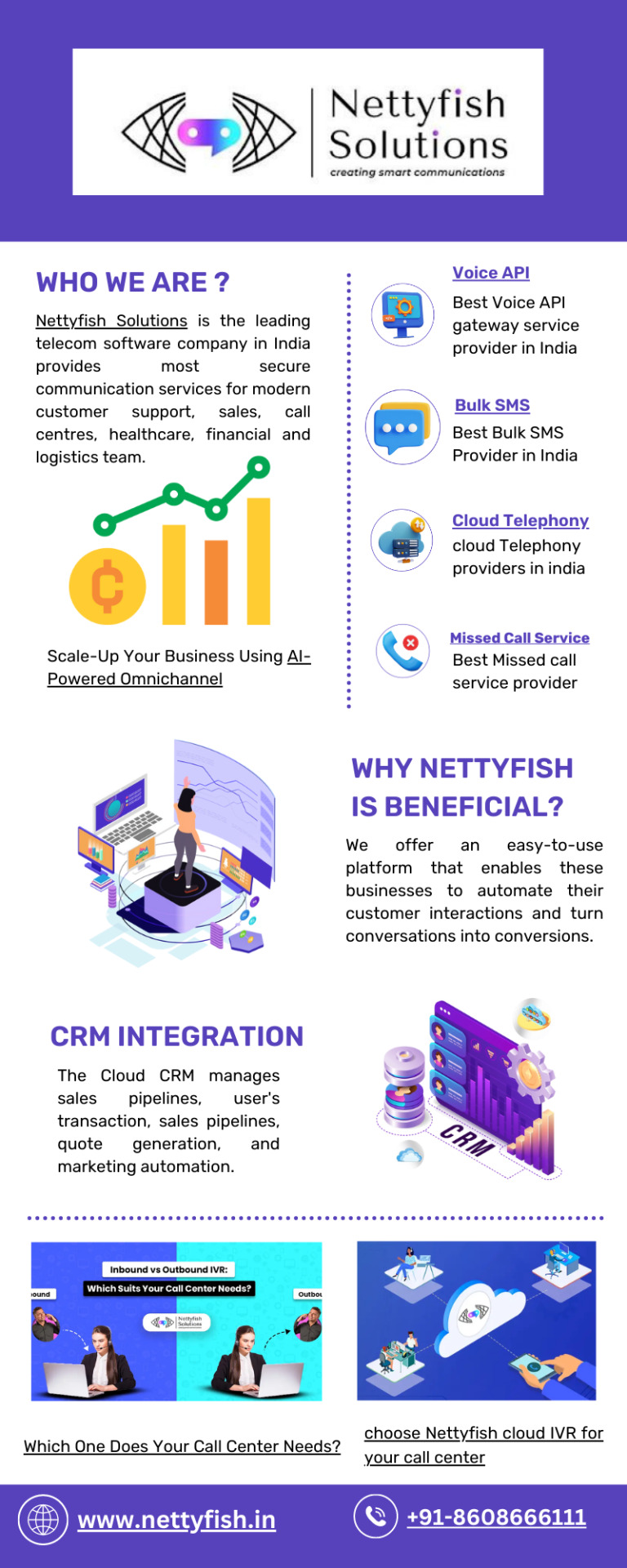
Scale-Up Your Business Using Nettyfish Solutions - A one stop destination for Enterprises . We offer Bulk SMS, Missed call service, Voice api, whatsapp api, sms api and more.
1 note
·
View note
Text
Writing Notes: Source Integration for Historical Writing

When writing for history courses, it is common to incorporate evidence from primary and secondary sources.
Writers integrate information from these sources into their writing in 3 ways:
Summaries
Writers typically summarize when the information from a source does not have to be provided in detail.
For example, a writer might want to summarize an author’s overall argument for the audience as opposed to explaining every line.
Summaries are particularly useful for describing key historical events or figures.
Writers can use descriptive facts, such as names, dates, and places, to create a summary that provides critical background information for the audience.
Example
In Kris Myers’ (2012, 198) essay, she traces the development of the Alice Paul Institute (API), also known as Paulsdale, a house museum that features historical lessons based on the life of women’s rights activist Alice Paul.
Paraphrases
Paraphrasing works best when writers can state information from a source in a more clear and concise manner without changing the original meaning of the words. Under most circumstances, readers expect to see paraphrased evidence in historical writing. Paraphrasing helps writers balance information from their sources with their own words and voice.
For example, if a writer wants to include an author’s idea to support their argument, but the original text spans an entire paragraph, the writer can paraphrase key details from the original paragraph into one or two sentences to capture the important aspects.
Example
Myers (2012, 198) states the API decided to use Alice Paul’s life as the foundation for a leadership program that teaches young girls skills to become leaders in their community.
Quotations
Quotations suit several purposes in writing.
The most common reasons writers use quotations are when the words serve as concrete evidence to back up a claim, come from an authoritative figure that adds credibility to their argument, are so compelling and original that there is no better way to express the idea, or communicate an idea in order to accurately dispute it.
For historical writing, quotations are used to reference primary and secondary sources as evidence to support an argument. However, writers should keep in mind that quotations from a primary source are often considered stronger forms of evidence than quotations from a secondary source.
Example
Despite the success of Paulsdale, Myers (2012, 207) notes that “[t]he API confronted constant claims that women’s history is not significant to American memory, or that women like Alice Paul represented a radical element” when advocating for the project.
Note: Always refer to assignment instructions for specific information regarding which citation style to use and how many sources or quotations are required.
Source ⚜ More: Writing Notes & References
#writing notes#history#studyblr#writeblr#dark academia#spilled ink#light academia#writers on tumblr#writing prompt#literature#poets on tumblr#poetry#lit#creative writing#writing tips#writing advice#research#writing inspiration#writing reference#konstantin gorbatov#post impressionism#art#writing resources
73 notes
·
View notes
Text
It's time for another outreach post to see if I can get you interested in guild wars 2!!!!! we kinda have to do our own marketing here. So here's some handpicked reasons why you might want to check it out if you've not heard of it!!
you're not the only hero

You're a hero, for sure, but the other characters are given attention and space to shine. They have their own voices, perspectives and flaws. While the game frames this as your story, there's deft character writing that doesn't always revolve around you, which is something I value about a genre that too often falls back on telling the player they're amazing instead of letting them feel at home.
the enormous list of top tier voice talent
all those well-developed characters are nearly always voiced, barring the incidental occasional text box. Their quirks come through, and there's nailed comedic timing. You don't have to read and read and read, even in the open world - all NPCs have voiced dialogue to engage you in your surroundings. (There's even a whole blog about it! @talk-of-tyria) Here are just SOME of the cast!

no subscription, low FOMO
I'm no fan of games that keep you dangled on the hook for more money. GW2 is a buy-to-keep game. It will never have a monthly fee. In fact, the base game, everything that released on launch, is free to own right now.
You can buy the expansions and episodes as you reach them if you want, or you can wait for a half price sale and get the entire, decade long entire saga for about 50 bucks, and that's a lot of game.
There are no missable items or events, everything will cycle back in, nor any pressure to get your money's worth of a monthly subscription. You're in control of how much you want to play, and you can take a break any time.
no gear treadmill

If you've played other MMOs, you might be familiar with an ever-increasing level cap, constant power creep, and the fear of taking time off from the game leaving your head earned equipment outdated. This is the gear treadmill, a tactic to keep you playing for numbers rather than enjoyment. GW2 doesn't have this.
You can earn armours with different stat boosts, and it stays just as useful as the day you got it. The level cap has never increased. Instead, you complete your character's vertical progression and shift onto horizontal - obtaining cosmetics, unlocking more utility for your mounts, or training abilities to help traverse maps with ease. You never need to 'catch up' when you're not playing.
new trailer and new player boost event
having newly launched on epic store, there's a refreshed official trailer to get a better sense of who you'll be in this world!
youtube
To give everyone a welcome bonus, there's a big exp boost in game until Nov 25th, although levelling is quite easy and non-grindy anyways. The game's supposed to be fun, not work.
This isn't even getting into how much I like the map design, the music, the quest overhaul and the sense of community. And the mounts and achievements and the ease of inventory clearing and storing materials. The overall attention to QoL ... did I mention the official, independent wiki with API integration and dialogue transcripts that can even be used in-game?
If you liked the sound of any of this, give it a shot! You can just start playing right now for no money!!! Maybe I'll see you in tyria!

23 notes
·
View notes
Text
SDMP Modlist
u/GalaxyCole wrote down all the mods on the server, shown by Lark on his stream!
direct link to the list, i'll put them also under read more
Forge 1.18.2 Grabby Mobs Copperized Beautify Player Animator Extra Trades Content Creaotr integration Not Enough Recipe Book Rubidium Mod Name Tooltip Looot Bow Infinity Fix Villager Names Duckling Golems Are Friends Not Resources JRFTL Placebo No Angled Brackets YUNG's API Another Liquid Milk Mod Extra Zombie Drops Customized Dungeon Loot Skeleton Horse Spawn Fakename Snow! Real Magic! Path Under Gates Chat Heads YUNG's Better Nether Fortresses dragonfight mod Cloth Config v4 API ChoiceTheorem's Overhauled Villages MmmMmmMmmMmm Despawning Eggs Hatch The Twilight Forest Hexxit Gear 2 Konkrete FlytreLib Farmer's Delight Curious Armor Stands Chefs Delight Ender's Delight Biommes O' Plenty Simple Shops Do a Barrel Roll TexelsPaintings Edibles SuperMartijn642's Core Lib Pop! Fairy Lights Bendy Lib Fish On The Line Highlighter Mystical Oak Tree Curious Lanterns Curios API Splashy Oculus Naturally Charged Creepers Collective Camera Mod StrongerSnowballs Villagers Sell Animals (by NoCube) Eating Animation Twilight Delight Architectury Name Tag tweaks Chimes Custom Window Title Camp Chair Detail Armor Bar FastLeafDecay CodeChicken Lib WaterFrames GeckoLib Nekos Enchanted Books Dark Paintings Sky Structures Dangerous Stone Cutter Better Advancements Drip Sounds Majrusz's Accessories Kiwi Notes Double Doors Torch Slab Mod Dice Watermedia Villagers Drops Emerals on Death Pitch Perfect DeathKnell Just Enough Items Captcha Contact Sooty Chimneys Falling Leaves Structory Silveroak Outpost Dual Riders Tumbleweed Nature's Compass Artifacts Smarter FArmers Jumpy Boats Configured CatJammies Skinned Carts Dungeon Crawl Obscuria's Tooltips Snow Under Trees Snuffles Rare Ice Food Effects Book Fishing Toast Control JEI Tweaker Blueprint Boatload Craft Tweaker Forge Passthrough Signs TheDirtyStuff Chalk Curious Lights Emotecrafft Wool Tweaks Selene Infernal Mobs Useless Sword Carpet Trapdoors [Forge] Simple Voice Chat Sound Physics Remastered TerraBlender SwingThroughGrass ExtraGore Mouse Tweaks Night Lights Emote Tweaks MMajrusz Library Creative Core Nethers Delight Chicken Chunks Special Drops Farming In Rain Iceberg Walking Canes Sit Goblin Community Backpacked Flower Patch Ambient Environment Neon Craft 2 Just Zoom AquaCulture 2 CHA&S Heartstone ExpandAbility Snowballs Freeze Mobs
#sdmp#sleep deprived multiplayer#op also said that they'll probably make it a modpack and link it later!#toad.txt
48 notes
·
View notes
Text
How Chatlayer's Conversational AI Enhances Lead Generation and Sales
Those days are gone when the only human-like conversations we used to have with fellow humans. It is 2025, and we are already in the future that we have always talked about. We have now set foot in a world where we can converse with robots. Now, that's pretty exciting. According to some, there may come a day when Artificial Intelligence (AI) takes over humans entirely. However, today is not that day. Today, let's appreciate the blessing that AI is to humanity and dive deep into the advantages of conversational AI-powered next-gen chatbots. Sinch Chatlayer This is our mission at Sinch. Our latest enhancement comes through the acquisition of Sinch Chatlayer. A cloud-based software platform that lets businesses create chatbots and voice bots in 100+ languages using Artificial Intelligence (AI) and Natural Language Understanding (NLU). Chatlayer provides analytics directly on the platform. Individual bot messages can be fully analysed and Chatlayer's dashboard features allow administrators to inspect the overall health of a particular bot. Chatlayer SaaS platform easily integrates with all major CRM, ticketing systems, knowledge base, and contact center solutions through our API. AI-based chatbot Artificial intelligence or AI-based chatbots are apps or interfaces that can carry on a human-like conversation using natural language understanding (NLU) or natural language processing (NLP) and machine learning. AI chatbots differ from standard chatbots because they leverage large language models (LLMs) versus traditional conversation flows and pre-programmed responses to generate responses to text and voice inputs. AI chatbots can improve customer experiences with virtual agents trained on a business's content and data, lower costs, and scale customer support. AI chatbot integration AI chatbot integration gives you instant AI-powered support, and Live chat adds the expertise of human agents, ensuring that every customer interaction is efficient and effective. Your customers can reach out to an AI chatbot anytime and get an instant response. Live agents will deliver a personalized experience when needed. Create a custom self-learning AI model based on your existing business data. Answer even the most complex queries with immediate responses using generative AI.
2 notes
·
View notes
Text
Vibecoding a production app
TL;DR I built and launched a recipe app with about 20 hours of work - recipeninja.ai
Background: I'm a startup founder turned investor. I taught myself (bad) PHP in 2000, and picked up Ruby on Rails in 2011. I'd guess 2015 was the last time I wrote a line of Ruby professionally. I've built small side projects over the years, but nothing with any significant usage. So it's fair to say I'm a little rusty, and I never really bothered to learn front end code or design.
In my day job at Y Combinator, I'm around founders who are building amazing stuff with AI every day and I kept hearing about the advances in tools like Lovable, Cursor and Windsurf. I love building stuff and I've always got a list of little apps I want to build if I had more free time.
About a month ago, I started playing with Lovable to build a word game based on Articulate (it's similar to Heads Up or Taboo). I got a working version, but I quickly ran into limitations - I found it very complicated to add a supabase backend, and it kept re-writing large parts of my app logic when I only wanted to make cosmetic changes. It felt like a toy - not ready to build real applications yet.
But I kept hearing great things about tools like Windsurf. A couple of weeks ago, I looked again at my list of app ideas to build and saw "Recipe App". I've wanted to build a hands-free recipe app for years. I love to cook, but the problem with most recipe websites is that they're optimized for SEO, not for humans. So you have pages and pages of descriptive crap to scroll through before you actually get to the recipe. I've used the recipe app Paprika to store my recipes in one place, but honestly it feels like it was built in 2009. The UI isn't great for actually cooking. My hands are covered in food and I don't really want to touch my phone or computer when I'm following a recipe.
So I set out to build what would become RecipeNinja.ai
For this project, I decided to use Windsurf. I wanted a Rails 8 API backend and React front-end app and Windsurf set this up for me in no time. Setting up homebrew on a new laptop, installing npm and making sure I'm on the right version of Ruby is always a pain. Windsurf did this for me step-by-step. I needed to set up SSH keys so I could push to GitHub and Heroku. Windsurf did this for me as well, in about 20% of the time it would have taken me to Google all of the relevant commands.
I was impressed that it started using the Rails conventions straight out of the box. For database migrations, it used the Rails command-line tool, which then generated the correct file names and used all the correct Rails conventions. I didn't prompt this specifically - it just knew how to do it. It one-shotted pretty complex changes across the React front end and Rails backend to work seamlessly together.
To start with, the main piece of functionality was to generate a complete step-by-step recipe from a simple input ("Lasagne"), generate an image of the finished dish, and then allow the user to progress through the recipe step-by-step with voice narration of each step. I used OpenAI for the LLM and ElevenLabs for voice. "Grandpa Spuds Oxley" gave it a friendly southern accent.
Recipe summary:
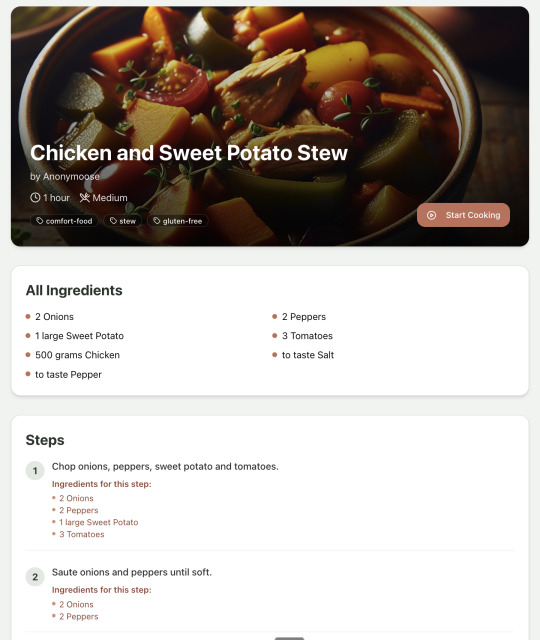
And the recipe step-by-step view:
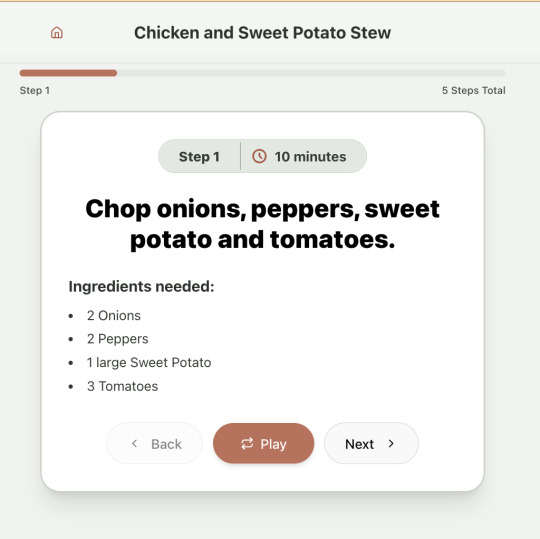
I was pretty astonished that Windsurf managed to integrate both the OpenAI and Elevenlabs APIs without me doing very much at all. After we had a couple of problems with the open AI Ruby library, it quickly fell back to a raw ruby HTTP client implementation, but I honestly didn't care. As long as it worked, I didn't really mind if it used 20 lines of code or two lines of code. And Windsurf was pretty good about enforcing reasonable security practices. I wanted to call Elevenlabs directly from the front end while I was still prototyping stuff, and Windsurf objected very strongly, telling me that I was risking exposing my private API credentials to the Internet. I promised I'd fix it before I deployed to production and it finally acquiesced.
I decided I wanted to add "Advanced Import" functionality where you could take a picture of a recipe (this could be a handwritten note or a picture from a favourite a recipe book) and RecipeNinja would import the recipe. This took a handful of minutes.
Pretty quickly, a pattern emerged; I would prompt for a feature. It would read relevant files and make changes for two or three minutes, and then I would test the backend and front end together. I could quickly see from the JavaScript console or the Rails logs if there was an error, and I would just copy paste this error straight back into Windsurf with little or no explanation. 80% of the time, Windsurf would correct the mistake and the site would work. Pretty quickly, I didn't even look at the code it generated at all. I just accepted all changes and then checked if it worked in the front end.
After a couple of hours of work on the recipe generation, I decided to add the concept of "Users" and include Google Auth as a login option. This would require extensive changes across the front end and backend - a database migration, a new model, new controller and entirely new UI. Windsurf one-shotted the code. It didn't actually work straight away because I had to configure Google Auth to add `localhost` as a valid origin domain, but Windsurf talked me through the changes I needed to make on the Google Auth website. I took a screenshot of the Google Auth config page and pasted it back into Windsurf and it caught an error I had made. I could login to my app immediately after I made this config change. Pretty mindblowing. You can now see who's created each recipe, keep a list of your own recipes, and toggle each recipe to public or private visibility. When I needed to set up Heroku to host my app online, Windsurf generated a bunch of terminal commands to configure my Heroku apps correctly. It went slightly off track at one point because it was using old Heroku APIs, so I pointed it to the Heroku docs page and it fixed it up correctly.
I always dreaded adding custom domains to my projects - I hate dealing with Registrars and configuring DNS to point at the right nameservers. But Windsurf told me how to configure my GoDaddy domain name DNS to work with Heroku, telling me exactly what buttons to press and what values to paste into the DNS config page. I pointed it at the Heroku docs again and Windsurf used the Heroku command line tool to add the "Custom Domain" add-ons I needed and fetch the right Heroku nameservers. I took a screenshot of the GoDaddy DNS settings and it confirmed it was right.
I can see very soon that tools like Cursor & Windsurf will integrate something like Browser Use so that an AI agent will do all this browser-based configuration work with zero user input.
I'm also impressed that Windsurf will sometimes start up a Rails server and use curl commands to check that an API is working correctly, or start my React project and load up a web preview and check the front end works. This functionality didn't always seem to work consistently, and so I fell back to testing it manually myself most of the time.
When I was happy with the code, it wrote git commits for me and pushed code to Heroku from the in-built command line terminal. Pretty cool!
I do have a few niggles still. Sometimes it's a little over-eager - it will make more changes than I want, without checking with me that I'm happy or the code works. For example, it might try to commit code and deploy to production, and I need to press "Stop" and actually test the app myself. When I asked it to add analytics, it went overboard and added 100 different analytics events in pretty insignificant places. When it got trigger-happy like this, I reverted the changes and gave it more precise commands to follow one by one.
The one thing I haven't got working yet is automated testing that's executed by the agent before it decides a task is complete; there's probably a way to do it with custom rules (I have spent zero time investigating this). It feels like I should be able to have an integration test suite that is run automatically after every code change, and then any test failures should be rectified automatically by the AI before it says it's finished.
Also, the AI should be able to tail my Rails logs to look for errors. It should spot things like database queries and automatically optimize my Active Record queries to make my app perform better. At the moment I'm copy-pasting in excerpts of the Rails logs, and then Windsurf quickly figures out that I've got an N+1 query problem and fixes it. Pretty cool.
Refactoring is also kind of painful. I've ended up with several files that are 700-900 lines long and contain duplicate functionality. For example, list recipes by tag and list recipes by user are basically the same.
Recipes by user:
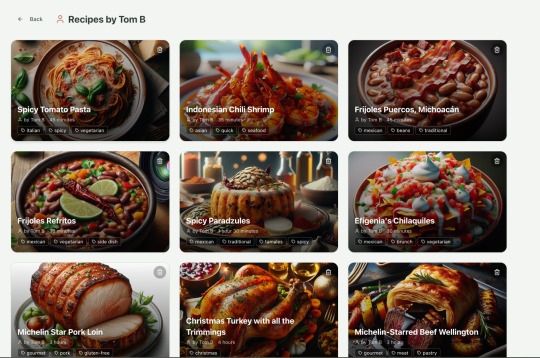
This should really be identical to list recipes by tag, but Windsurf has implemented them separately.
Recipes by tag:
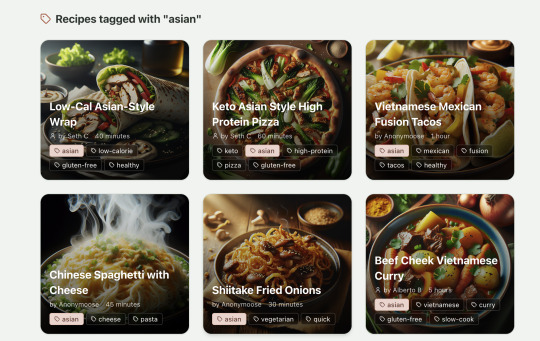
If I ask Windsurf to refactor these two pages, it randomly changes stuff like renaming analytics events, rewriting user-facing alerts, and changing random little UX stuff, when I really want to keep the functionality exactly the same and only move duplicate code into shared modules. Instead, to successfully refactor, I had to ask Windsurf to list out ideas for refactoring, then prompt it specifically to refactor these things one by one, touching nothing else. That worked a little better, but it still wasn't perfect
Sometimes, adding minor functionality to the Rails API will often change the entire API response, rather just adding a couple of fields. Eg It will occasionally change Index Recipes to nest responses in an object { "recipes": [ ] }, versus just returning an array, which breaks the frontend. And then another minor change will revert it. This is where adding tests to identify and prevent these kinds of API changes would be really useful. When I ask Windsurf to fix these API changes, it will instead change the front end to accept the new API json format and also leave the old implementation in for "backwards compatibility". This ends up with a tangled mess of code that isn't really necessary. But I'm vibecoding so I didn't bother to fix it.
Then there was some changes that just didn't work at all. Trying to implement Posthog analytics in the front end seemed to break my entire app multiple times. I tried to add user voice commands ("Go to the next step"), but this conflicted with the eleven labs voice recordings. Having really good git discipline makes vibe coding much easier and less stressful. If something doesn't work after 10 minutes, I can just git reset head --hard. I've not lost very much time, and it frees me up to try more ambitious prompts to see what the AI can do. Less technical users who aren't familiar with git have lost months of work when the AI goes off on a vision quest and the inbuilt revert functionality doesn't work properly. It seems like adding more native support for version control could be a massive win for these AI coding tools.
Another complaint I've heard is that the AI coding tools don't write "production" code that can scale. So I decided to put this to the test by asking Windsurf for some tips on how to make the application more performant. It identified I was downloading 3 MB image files for each recipe, and suggested a Rails feature for adding lower resolution image variants automatically. Two minutes later, I had thumbnail and midsize variants that decrease the loading time of each page by 80%. Similarly, it identified inefficient N+1 active record queries and rewrote them to be more efficient. There are a ton more performance features that come built into Rails - caching would be the next thing I'd probably add if usage really ballooned.
Before going to production, I kept my promise to move my Elevenlabs API keys to the backend. Almost as an afterthought, I asked asked Windsurf to cache the voice responses so that I'd only make an Elevenlabs API call once for each recipe step; after that, the audio file was stored in S3 using Rails ActiveStorage and served without costing me more credits. Two minutes later, it was done. Awesome.
At the end of a vibecoding session, I'd write a list of 10 or 15 new ideas for functionality that I wanted to add the next time I came back to the project. In the past, these lists would've built up over time and never gotten done. Each task might've taken me five minutes to an hour to complete manually. With Windsurf, I was astonished how quickly I could work through these lists. Changes took one or two minutes each, and within 30 minutes I'd completed my entire to do list from the day before. It was astonishing how productive I felt. I can create the features faster than I can come up with ideas.
Before launching, I wanted to improve the design, so I took a quick look at a couple of recipe sites. They were much more visual than my site, and so I simply told Windsurf to make my design more visual, emphasizing photos of food. Its first try was great. I showed it to a couple of friends and they suggested I should add recipe categories - "Thai" or "Mexican" or "Pizza" for example. They showed me the DoorDash app, so I took a screenshot of it and pasted it into Windsurf. My prompt was "Give me a carousel of food icons that look like this". Again, this worked in one shot. I think my version actually looks better than Doordash 🤷♂️
Doordash:
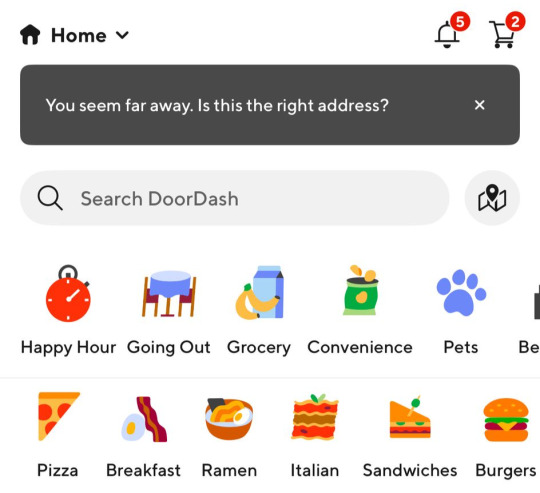
My carousel:

I also saw I was getting a console error from missing Favicon. I always struggle to make Favicon for previous sites because I could never figure out where they were supposed to go or what file format they needed. I got OpenAI to generate me a little recipe ninja icon with a transparent background and I saved it into my project directory. I asked Windsurf what file format I need and it listed out nine different sizes and file formats. Seems annoying. I wondered if Windsurf could just do it all for me. It quickly wrote a series of Bash commands to create a temporary folder, resize the image and create the nine variants I needed. It put them into the right directory and then cleaned up the temporary directory. I laughed in amazement. I've never been good at bash scripting and I didn't know if it was even possible to do what I was asking via the command line. I guess it is possible.

After launching and posting on Twitter, a few hundred users visited the site and generated about 1000 recipes. I was pretty happy! Unfortunately, the next day I woke up and saw that I had a $700 OpenAI bill. Someone had been abusing the site and costing me a lot of OpenAI credits by creating a single recipe over and over again - "Pasta with Shallots and Pineapple". They did this 12,000 times. Obviously, I had not put any rate limiting in.
Still, I was determined not to write any code. I explained the problem and asked Windsurf to come up with solutions. Seconds later, I had 15 pretty good suggestions. I implemented several (but not all) of the ideas in about 10 minutes and the abuse stopped dead in its tracks. I won't tell you which ones I chose in case Mr Shallots and Pineapple is reading. The app's security is not perfect, but I'm pretty happy with it for the scale I'm at. If I continue to grow and get more abuse, I'll implement more robust measures.
Overall, I am astonished how productive Windsurf has made me in the last two weeks. I'm not a good designer or frontend developer, and I'm a very rusty rails dev. I got this project into production 5 to 10 times faster than it would've taken me manually, and the level of polish on the front end is much higher than I could've achieved on my own. Over and over again, I would ask for a change and be astonished at the speed and quality with which Windsurf implemented it. I just sat laughing as the computer wrote code.
The next thing I want to change is making the recipe generation process much more immediate and responsive. Right now, it takes about 20 seconds to generate a recipe and for a new user it feels like maybe the app just isn't doing anything.
Instead, I'm experimenting with using Websockets to show a streaming response as the recipe is created. This gives the user immediate feedback that something is happening. It would also make editing the recipe really fun - you could ask it to "add nuts" to the recipe, and see as the recipe dynamically updates 2-3 seconds later. You could also say "Increase the quantities to cook for 8 people" or "Change from imperial to metric measurements".
I have a basic implementation working, but there are still some rough edges. I might actually go and read the code this time to figure out what it's doing!
I also want to add a full voice agent interface so that you don't have to touch the screen at all. Halfway through cooking a recipe, you might ask "I don't have cilantro - what could I use instead?" or say "Set a timer for 30 minutes". That would be my dream recipe app!
Tools like Windsurf or Cursor aren't yet as useful for non-technical users - they're extremely powerful and there are still too many ways to blow your own face off. I have a fairly good idea of the architecture that I want Windsurf to implement, and I could quickly spot when it was going off track or choosing a solution that was inappropriately complicated for the feature I was building. At the moment, a technical background is a massive advantage for using Windsurf. As a rusty developer, it made me feel like I had superpowers.
But I believe within a couple of months, when things like log tailing and automated testing and native version control get implemented, it will be an extremely powerful tool for even non-technical people to write production-quality apps. The AI will be able to make complex changes and then verify those changes are actually working. At the moment, it feels like it's making a best guess at what will work and then leaving the user to test it. Implementing better feedback loops will enable a truly agentic, recursive, self-healing development flow. It doesn't feel like it needs any breakthrough in technology to enable this. It's just about adding a few tool calls to the existing LLMs. My mind races as I try to think through the implications for professional software developers.
Meanwhile, the LLMs aren't going to sit still. They're getting better at a frightening rate. I spoke to several very capable software engineers who are Y Combinator founders in the last week. About a quarter of them told me that 95% of their code is written by AI. In six or twelve months, I just don't think software engineering is going exist in the same way as it does today. The cost of creating high-quality, custom software is quickly trending towards zero.
You can try the site yourself at recipeninja.ai
Here's a complete list of functionality. Of course, Windsurf just generated this list for me 🫠
RecipeNinja: Comprehensive Functionality Overview
Core Concept: the app appears to be a cooking assistant application that provides voice-guided recipe instructions, allowing users to cook hands-free while following step-by-step recipe guidance.
Backend (Rails API) Functionality
User Authentication & Authorization
Google OAuth integration for user authentication
User account management with secure authentication flows
Authorization system ensuring users can only access their own private recipes or public recipes
Recipe Management
Recipe Model Features:
Unique public IDs (format: "r_" + 14 random alphanumeric characters) for security
User ownership (user_id field with NOT NULL constraint)
Public/private visibility toggle (default: private)
Comprehensive recipe data storage (title, ingredients, steps, cooking time, etc.)
Image attachment capability using Active Storage with S3 storage in production
Recipe Tagging System:
Many-to-many relationship between recipes and tags
Tag model with unique name attribute
RecipeTag join model for the relationship
Helper methods for adding/removing tags from recipes
Recipe API Endpoints:
CRUD operations for recipes
Pagination support with metadata (current_page, per_page, total_pages, total_count)
Default sorting by newest first (created_at DESC)
Filtering recipes by tags
Different serializers for list view (RecipeSummarySerializer) and detail view (RecipeSerializer)
Voice Generation
Voice Recording System:
VoiceRecording model linked to recipes
Integration with Eleven Labs API for text-to-speech conversion
Caching of voice recordings in S3 to reduce API calls
Unique identifiers combining recipe_id, step_id, and voice_id
Force regeneration option for refreshing recordings
Audio Processing:
Using streamio-ffmpeg gem for audio file analysis
Active Storage integration for audio file management
S3 storage for audio files in production
Recipe Import & Generation
RecipeImporter Service:
OpenAI integration for recipe generation
Conversion of text recipes into structured format
Parsing and normalization of recipe data
Import from photos functionality
Frontend (React) Functionality
User Interface Components
Recipe Selection & Browsing:
Recipe listing with pagination
Real-time updates with 10-second polling mechanism
Tag filtering functionality
Recipe cards showing summary information (without images)
"View Details" and "Start Cooking" buttons for each recipe
Recipe Detail View:
Complete recipe information display
Recipe image display
Tag display with clickable tags
Option to start cooking from this view
Cooking Experience:
Step-by-step recipe navigation
Voice guidance for each step
Keyboard shortcuts for hands-free control:
Arrow keys for step navigation
Space for play/pause audio
Escape to return to recipe selection
URL-based step tracking (e.g., /recipe/r_xlxG4bcTLs9jbM/classic-lasagna/steps/1)
State Management & Data Flow
Recipe Service:
API integration for fetching recipes
Support for pagination parameters
Tag-based filtering
Caching mechanisms for recipe data
Image URL handling for detailed views
Authentication Flow:
Google OAuth integration using environment variables
User session management
Authorization header management for API requests
Progressive Web App Features
PWA capabilities for installation on devices
Responsive design for various screen sizes
Favicon and app icon support
Deployment Architecture
Two-App Structure:
cook-voice-api: Rails backend on Heroku
cook-voice-wizard: React frontend/PWA on Heroku
Backend Infrastructure:
Ruby 3.2.2
PostgreSQL database (Heroku PostgreSQL addon)
Amazon S3 for file storage
Environment variables for configuration
Frontend Infrastructure:
React application
Environment variable configuration
Static buildpack on Heroku
SPA routing configuration
Security Measures:
HTTPS enforcement
Rails credentials system
Environment variables for sensitive information
Public ID system to mask database IDs
This comprehensive overview covers the major functionality of the Cook Voice application based on the available information. The application appears to be a sophisticated cooking assistant that combines recipe management with voice guidance to create a hands-free cooking experience.
2 notes
·
View notes
Text
youtube
People Think It’s Fake" | DeepSeek vs ChatGPT: The Ultimate 2024 Comparison (SEO-Optimized Guide)
The AI wars are heating up, and two giants—DeepSeek and ChatGPT—are battling for dominance. But why do so many users call DeepSeek "fake" while praising ChatGPT? Is it a myth, or is there truth to the claims? In this deep dive, we’ll uncover the facts, debunk myths, and reveal which AI truly reigns supreme. Plus, learn pro SEO tips to help this article outrank competitors on Google!
Chapters
00:00 Introduction - DeepSeek: China’s New AI Innovation
00:15 What is DeepSeek?
00:30 DeepSeek’s Impressive Statistics
00:50 Comparison: DeepSeek vs GPT-4
01:10 Technology Behind DeepSeek
01:30 Impact on AI, Finance, and Trading
01:50 DeepSeek’s Effect on Bitcoin & Trading
02:10 Future of AI with DeepSeek
02:25 Conclusion - The Future is Here!
Why Do People Call DeepSeek "Fake"? (The Truth Revealed)
The Language Barrier Myth
DeepSeek is trained primarily on Chinese-language data, leading to awkward English responses.
Example: A user asked, "Write a poem about New York," and DeepSeek referenced skyscrapers as "giant bamboo shoots."
SEO Keyword: "DeepSeek English accuracy."
Cultural Misunderstandings
DeepSeek’s humor, idioms, and examples cater to Chinese audiences. Global users find this confusing.
ChatGPT, trained on Western data, feels more "relatable" to English speakers.
Lack of Transparency
Unlike OpenAI’s detailed GPT-4 technical report, DeepSeek’s training data and ethics are shrouded in secrecy.
LSI Keyword: "DeepSeek data sources."
Viral "Fail" Videos
TikTok clips show DeepSeek claiming "The Earth is flat" or "Elon Musk invented Bitcoin." Most are outdated or edited—ChatGPT made similar errors in 2022!
DeepSeek vs ChatGPT: The Ultimate 2024 Comparison
1. Language & Creativity
ChatGPT: Wins for English content (blogs, scripts, code).
Strengths: Natural flow, humor, and cultural nuance.
Weakness: Overly cautious (e.g., refuses to write "controversial" topics).
DeepSeek: Best for Chinese markets (e.g., Baidu SEO, WeChat posts).
Strengths: Slang, idioms, and local trends.
Weakness: Struggles with Western metaphors.
SEO Tip: Use keywords like "Best AI for Chinese content" or "DeepSeek Baidu SEO."
2. Technical Abilities
Coding:
ChatGPT: Solves Python/JavaScript errors, writes clean code.
DeepSeek: Better at Alibaba Cloud APIs and Chinese frameworks.
Data Analysis:
Both handle spreadsheets, but DeepSeek integrates with Tencent Docs.
3. Pricing & Accessibility
FeatureDeepSeekChatGPTFree TierUnlimited basic queriesGPT-3.5 onlyPro Plan$10/month (advanced Chinese tools)$20/month (GPT-4 + plugins)APIsCheaper for bulk Chinese tasksGlobal enterprise support
SEO Keyword: "DeepSeek pricing 2024."
Debunking the "Fake AI" Myth: 3 Case Studies
Case Study 1: A Shanghai e-commerce firm used DeepSeek to automate customer service on Taobao, cutting response time by 50%.
Case Study 2: A U.S. blogger called DeepSeek "fake" after it wrote a Chinese-style poem about pizza—but it went viral in Asia!
Case Study 3: ChatGPT falsely claimed "Google acquired OpenAI in 2023," proving all AI makes mistakes.
How to Choose: DeepSeek or ChatGPT?
Pick ChatGPT if:
You need English content, coding help, or global trends.
You value brand recognition and transparency.
Pick DeepSeek if:
You target Chinese audiences or need cost-effective APIs.
You work with platforms like WeChat, Douyin, or Alibaba.
LSI Keyword: "DeepSeek for Chinese marketing."
SEO-Optimized FAQs (Voice Search Ready!)
"Is DeepSeek a scam?" No! It’s a legitimate AI optimized for Chinese-language tasks.
"Can DeepSeek replace ChatGPT?" For Chinese users, yes. For global content, stick with ChatGPT.
"Why does DeepSeek give weird answers?" Cultural gaps and training focus. Use it for specific niches, not general queries.
"Is DeepSeek safe to use?" Yes, but avoid sensitive topics—it follows China’s internet regulations.
Pro Tips to Boost Your Google Ranking
Sprinkle Keywords Naturally: Use "DeepSeek vs ChatGPT" 4–6 times.
Internal Linking: Link to related posts (e.g., "How to Use ChatGPT for SEO").
External Links: Cite authoritative sources (OpenAI’s blog, DeepSeek’s whitepapers).
Mobile Optimization: 60% of users read via phone—use short paragraphs.
Engagement Hooks: Ask readers to comment (e.g., "Which AI do you trust?").
Final Verdict: Why DeepSeek Isn’t Fake (But ChatGPT Isn’t Perfect)
The "fake" label stems from cultural bias and misinformation. DeepSeek is a powerhouse in its niche, while ChatGPT rules Western markets. For SEO success:
Target long-tail keywords like "Is DeepSeek good for Chinese SEO?"
Use schema markup for FAQs and comparisons.
Update content quarterly to stay ahead of AI updates.
🚀 Ready to Dominate Google? Share this article, leave a comment, and watch it climb to #1!
Follow for more AI vs AI battles—because in 2024, knowledge is power! 🔍
#ChatGPT alternatives#ChatGPT features#ChatGPT vs DeepSeek#DeepSeek AI review#DeepSeek vs OpenAI#Generative AI tools#chatbot performance#deepseek ai#future of nlp#deepseek vs chatgpt#deepseek#chatgpt#deepseek r1 vs chatgpt#chatgpt deepseek#deepseek r1#deepseek v3#deepseek china#deepseek r1 ai#deepseek ai model#china deepseek ai#deepseek vs o1#deepseek stock#deepseek r1 live#deepseek vs chatgpt hindi#what is deepseek#deepseek v2#deepseek kya hai#Youtube
2 notes
·
View notes
Text
Voice API Integration
Sinch India’s voice API integration provides businesses with the capability to embed voice call features directly into their applications. This integration allows you to automate communication, offer customer support, and even facilitate transactions through voice calls. Whether you need to set up a virtual call center or integrate voice capabilities into your e-commerce platform, Sinch India’s APIs simplify the process. It ensures scalability and flexibility, allowing businesses to create personalized and efficient communication channels with customers, ensuring high-quality interactions without the need for extensive infrastructure.
4 notes
·
View notes
Text



Thanks to my partners, and to anok, autumn leaf cascade, enkidu, ingrate, rice boy, and taigarun, all long-term and thoughtful contributors to anarchy101.org. Thanks also to the others on that site (including many anonymous questionners). I truly appreciate getting to have provocative conversations about things I care about with people who I don’t even know.
And thanks to Jessica, the excellent beginner.
I hope I have done justice to us all.
Introduction
Anarchy is many things to different people: a vision, a plan, a conversation, a process. It is my view (consistent with a whole raft of contemporary anarchists, from Alfredo M. Bonanno to Voltairine de Cleyre and beyond) that anarchy is best understood, and is most helpful, as a tension, a question, a rejection. This text operates from that premise.
This book is composed of questions, answers, and comments (sometimes lightly edited) taken from a website called anarchy101.org, in which various anarchists answer questions posed by themselves and others. This variety of voices (the answers and comments disagree with each other as often as agree) is integral to any anarchist project that I want to be a part of. There are many more questions there than could reasonably fit into a book, so go, read, ask, and argue.
We welcome your engagement with these ideas, and look forward to hearing your voice in the future.
In the following pages you will meet
AnarchicSaint: ast
Anok: ank
Apio: api
Asker: asr
Aragorn: a!
Aragorn23: a23
Autumn Leaf Cascade: alc
Blacque: blq
Dot: dot
Enkidu: enk
Frenzy: frz
Funkyanarchy: fnk
Iconoclast: ict
Ingrate: ing
Inpraiseofchaos: ipc
KatherineD: kd
Lawrence: law
Madlib: mdb
MrThisBody: mtb
MattThePrick: mtp
MollytheAnarchist: mta
Nothing Resonates: nnn
Rice Boy: rby
Sabotage: sab
Squee: squ
Taigarun: tgn
Vindico Vaco: vvo
#FAQ#intro#anarchism#anarchy#anarchist society#practical anarchy#practical anarchism#resistance#autonomy#revolution#communism#anti capitalist#anti capitalism#late stage capitalism#daily posts#libraries#leftism#social issues#anarchy works#anarchist library#survival#freedom#introduction#dot matrix#AnarchicSaint: ast#Anok: ank#Apio: api#Asker: asr#Aragorn: a!#Aragorn23: a23
3 notes
·
View notes
Text
Voice analysis tools for developers
Voice analysis tools for developers give capabilities for Emotional analysis, Voice recognition, and Mood analysis. These tools help interpret emotions, recognize speech patterns, and analyze user moods efficiently.
#Emotion Analysis Through voice#Emotional quotient API integration#Voice analysis tools for developers#Speech-based mood assessment#Real-time emotional analysis software
0 notes
Text
What are the latest technological advancements shaping the future of fintech?

The financial technology (fintech) industry has witnessed an unprecedented wave of innovation over the past decade, reshaping how people and businesses manage money. As digital transformation accelerates, fintech new technologies are emerging, revolutionizing payments, lending, investments, and other financial services. These advancements, driven by fintech innovation, are not only enhancing user experience but also fostering greater financial inclusion and efficiency.
In this article, we will explore the most significant fintech trending technologies that are shaping the future of the industry. From blockchain to artificial intelligence, these innovations are redefining the boundaries of what fintech can achieve.
1. Blockchain and Cryptocurrencies
One of the most transformative advancements in fintech is the adoption of blockchain technology. Blockchain serves as the foundation for cryptocurrencies like Bitcoin, Ethereum, and stablecoins. Its decentralized, secure, and transparent nature has made it a game-changer in areas such as payments, remittances, and asset tokenization.
Key Impacts of Blockchain:
Decentralized Finance (DeFi): Blockchain is driving the rise of DeFi, which eliminates intermediaries like banks in financial transactions. DeFi platforms offer lending, borrowing, and trading services, accessible to anyone with an internet connection.
Cross-Border Payments: Blockchain simplifies and accelerates international transactions, reducing costs and increasing transparency.
Smart Contracts: These self-executing contracts are automating and securing financial agreements, streamlining operations across industries.
As blockchain adoption grows, businesses are exploring how to integrate this technology into their offerings to increase trust and efficiency.
2. Artificial Intelligence (AI) and Machine Learning (ML)
AI and ML are at the core of fintech innovation, enabling smarter and more efficient financial services. These technologies are being used to analyze vast amounts of data, predict trends, and automate processes.
Applications of AI and ML:
Fraud Detection and Prevention: AI models detect anomalies and fraudulent transactions in real-time, enhancing security for both businesses and customers.
Personalized Financial Services: AI-driven chatbots and virtual assistants are offering tailored advice, improving customer engagement.
Credit Scoring: AI-powered algorithms provide more accurate and inclusive credit assessments, helping underserved populations gain access to loans.
AI and ML are enabling fintech companies to deliver faster, more reliable services while minimizing operational risks.
3. Open Banking
Open banking is one of the most significant fintech trending technologies, promoting collaboration between banks, fintechs, and third-party providers. It allows customers to share their financial data securely with authorized parties through APIs (Application Programming Interfaces).
Benefits of Open Banking:
Enhanced Financial Management: Aggregated data helps users better manage their finances across multiple accounts.
Increased Competition: Open banking fosters innovation, as fintech startups can create solutions tailored to specific customer needs.
Seamless Payments: Open banking APIs enable instant and direct payments, reducing reliance on traditional methods.
Open banking is paving the way for a more connected and customer-centric financial ecosystem.
4. Biometric Authentication
Security is paramount in the financial industry, and fintech innovation has led to the rise of biometric authentication. By using physical characteristics such as fingerprints, facial recognition, or voice patterns, biometric technologies enhance security while providing a seamless user experience.
Advantages of Biometric Authentication:
Improved Security: Biometrics significantly reduce the risk of fraud by making it difficult for unauthorized users to access accounts.
Faster Transactions: Users can authenticate themselves quickly, leading to smoother digital payment experiences.
Convenience: With no need to remember passwords, biometrics offer a more user-friendly approach to security.
As mobile banking and digital wallets gain popularity, biometric authentication is becoming a standard feature in fintech services.
5. Embedded Finance
Embedded finance involves integrating financial services into non-financial platforms, such as e-commerce websites or ride-hailing apps. This fintech new technology allows businesses to offer services like loans, insurance, or payment options directly within their applications.
Examples of Embedded Finance:
Buy Now, Pay Later (BNPL): E-commerce platforms enable customers to purchase products on credit, enhancing sales and customer satisfaction.
In-App Payments: Users can make seamless transactions without leaving the platform, improving convenience.
Insurance Integration: Platforms offer tailored insurance products at the point of sale.
Embedded finance is creating new revenue streams for businesses while simplifying the customer journey.
6. RegTech (Regulatory Technology)
As financial regulations evolve, fintech innovation is helping businesses stay compliant through RegTech solutions. These technologies automate compliance processes, reducing costs and minimizing errors.
Key Features of RegTech:
Automated Reporting: Streamlines regulatory reporting requirements, saving time and resources.
Risk Management: Identifies and mitigates potential risks through predictive analytics.
KYC and AML Compliance: Simplifies Know Your Customer (KYC) and Anti-Money Laundering (AML) processes.
RegTech ensures that fintech companies remain agile while adhering to complex regulatory frameworks.
7. Cloud Computing
Cloud computing has revolutionized the way fintech companies store and process data. By leveraging the cloud, businesses can scale rapidly and deliver services more efficiently.
Benefits of Cloud Computing:
Scalability: Enables businesses to handle large transaction volumes without investing in physical infrastructure.
Cost-Effectiveness: Reduces operational costs by eliminating the need for on-premise servers.
Data Security: Advanced cloud platforms offer robust security measures to protect sensitive financial data.
Cloud computing supports the rapid growth of fintech companies, ensuring reliability and flexibility.
The Role of Xettle Technologies in Fintech Innovation
Companies like Xettle Technologies are at the forefront of fintech new technologies, driving advancements that make financial services more accessible and efficient. With a focus on delivering cutting-edge solutions, Xettle Technologies helps businesses integrate the latest fintech trending technologies into their operations. From AI-powered analytics to secure cloud-based platforms, Xettle Technologies is empowering organizations to stay competitive in an ever-evolving industry.
Conclusion
The future of fintech is being shaped by transformative technologies that are redefining how financial services are delivered and consumed. From blockchain and AI to open banking and biometric authentication, these fintech new technologies are driving efficiency, security, and inclusivity. As companies like Xettle Technologies continue to innovate, the industry will unlock even greater opportunities for businesses and consumers alike. By embracing these fintech trending advancements, organizations can stay ahead of the curve and thrive in a dynamic financial landscape.
2 notes
·
View notes
Text
What is Narrot? Automate your first line support with AI chat agents
Narrot is a cutting-edge AI-powered tool designed to streamline customer support processes. By leveraging advanced natural language processing and machine learning, Narrot provides an automated solution for customer interactions. It enables businesses to offer quick, accurate, and round-the-clock support, effectively reducing response times and improving customer satisfaction.
Features:
AI-Powered Automation: Automates customer queries with high accuracy, freeing up time for support teams.
24/7 Availability: Ensures customers receive help anytime, boosting overall satisfaction.
Multi-Channel Support: Integrates with various platforms to manage customer queries from multiple sources.
Customizable Responses: Tailor responses to align with brand voice and customer needs.
Analytics and Insights: Offers detailed analytics to help businesses refine their support strategy.
Uses: Ideal for customer service teams and businesses looking to enhance their support capabilities, Narrot assists by automating repetitive tasks and providing seamless customer support across channels. This tool helps reduce workload, improve efficiency, and maintain a consistent, high-quality customer experience.
2 notes
·
View notes
Text
Use the Right Whatsapp Message to Communicate Better To Promote Business
WhatsApp become the right platform for communication in both personal and professional contexts. It reaches a large user base and provides free and easy communication. If you are an official business, you should switch to the WhatsApp Business API. You have to check out the whatsapp message api pricing before going to hire a service. Businesses may incorporate WhatsApp's messaging features into their apps with the help of this potent technology.
Benefits of WhatsApp Business API
For businesses trying to develop relationships with their clients, WhatsApp Business API is a one-time expense. Let us explore the ten greatest benefits of the WhatsApp business API. Capabilities for real-time messaging in one app connected to the cloud are WhatsApp Business API. Real-time message sending and receiving is the biggest benefit. This instantaneous dialogue and interaction with your clients offers immediate assistance and answers their questions. For example, you can answer right away to a customer's question regarding whether a particular product is available. This facilitates effective communication and encourages them to purchase it.
Increased customer satisfaction:
A component of the API enables chatbots or pre-written message templates to provide instantaneous answers to frequently asked questions. This implies that even beyond business hours, clients obtain prompt responses. You can set up an automatic message to respond to a customer's inquiry regarding the shipment status of their order in real-time, guaranteeing their pleasure and cutting down on response time.
Personalized interactions
It is not feasible to manually compile information about your customers' preferences based on their transactions or interactions. This problem is resolved by the WhatsApp Business API, which collects client data and uses it to provide tailored messages. Provide customized product recommendations to customers based on their past purchases or searches. Customers are drawn to your website by targeted messaging, increasing the likelihood of a successful sale.
Multimedia messaging options
The WhatsApp Business API offers free support for rich multimedia communications, in contrast to regular SMS. Using WhatsApp, you may send your clients documents, photos, videos, and even voice snippets. This creates innovative opportunities for grabbing clients' attention graphically. Send infographics to your clients to highlight your most recent products so they can view the specifics and decide what to buy.
Automated responses and chatbots
WhatsApp Business API's ability to use chatbots and automated responses is one of its main features. You can program responses to be sent out automatically in the event that a consumer contacts your company with a typical question, like finding out the status of an order. With the WhatsApp API, a chatbot may be integrated to offer immediate assistance. Time is saved, and timely and consistent customer service is guaranteed.
Conclusion:
You are able to manage several discussions at once with efficiency. By allocating support agents to individual chats, the API is an excellent method of guaranteeing that clients receive prompt responses. Using automated routing increases client loyalty and happiness. The WhatsApp business API cost helps to provide great support at all times. The WhatsApp Business API enables better response times and round-the-clock accessibility. In contrast to conventional customer care channels that have set hours of operation, WhatsApp allows businesses to offer 24/7 service.
2 notes
·
View notes